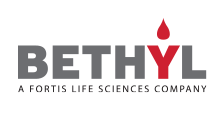Rabbit anti-ASPP2 Antibody Affinity Purified

Product Details
Specifications
The epitope recognized by A300-819A maps to a region between residue 425 and 475 of human Apoptosis-Stimulating Protein of p53, 2 (53BP2) using the numbering given in entry NP_001026855.1 (GeneID 7159).
Immunoglobulin concentration was determined using Beer’s Law where 1mg/mL IgG has an A280 of 1.4. Antibody was affinity purified using an epitope specific to ASPP2 immobilized on solid support.
The epitope recognized by A300-819A-T maps to a region between residue 425 and 475 of human Apoptosis-Stimulating Protein of p53, 2 (53BP2) using the numbering given in entry NP_001026855.1 (GeneID 7159).
Additional Product Information
The Apoptosis-Stimulating Protein of P53 (ASPP) family of proteins is comprised of ASPP1, ASPP2 and iASPP. ASPP1 and ASPP2 function to direct the cell away from cell cycle arrest and towards death by activating p53 family members, while iASPP functions to inhibit p53 mediated apoptosis. ASPP proteins have been shown to interact with p53, Bcl-2, and ReLA/p65.
Alternate Names
53BP2; apoptosis-stimulating of p53 protein 2; apoptosis-stimulating protein of p53, 2; ASPP2; BBP; BCL2-binding protein; p53-binding protein 2; P53BP2; PPP1R13A; renal carcinoma antigen NY-REN-51; tumor suppressor p53-binding protein 2
Applications
All western blot analysis is performed using 5% Milk-TBST for blocking and as antibody diluent. Primary antibody is incubated overnight.
Western blots of cell lysates are performed using Goat anti-Rabbit IgG Heavy and Light Chain Antibody (Cat. No. A120-101P).
Western blots of immunoprecipitates are performed using Goat anti-Rabbit Light Chain HRP Conjugate (Cat. No. A120-113P) with 5% Normal Pig Serum (Cat. No. S100-020) added to the blocking buffer.
